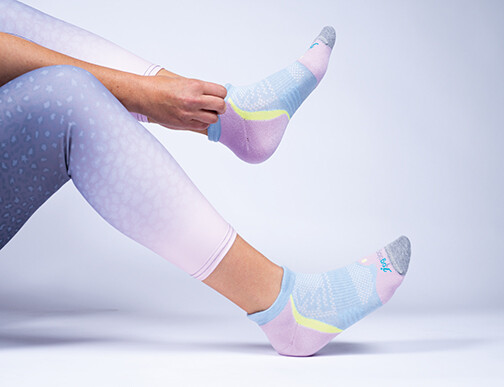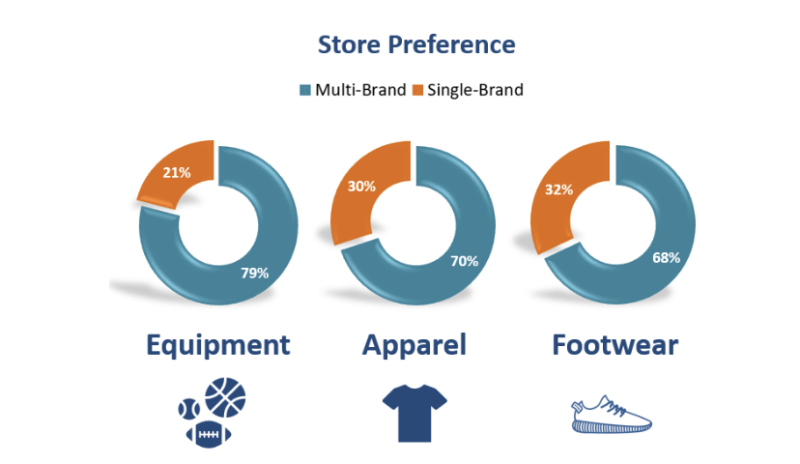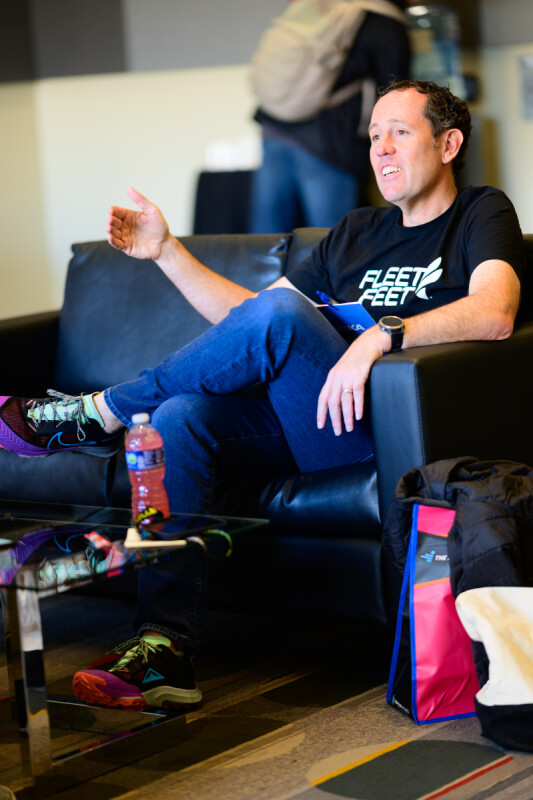There is an argument put forth by many in the run specialty business – and especially by the vendors profiled starting on page 50 – that a good running sock is just important as a good running shoe. Apparently, a lot of retailers and their customers agree.
Indeed, socks are such an integral part of a runner’s performance that design advances and features such as blister prevention, moisture wicking and odor control are huge selling points for runners looking for the best sock. So, what are run retailers doing to ensure their customers get their feet in the right socks? For many, it’s as simple as understanding the unique needs of the runners in their community.
“Running socks give us an opportunity to show our knowledge to the customer and separate ourselves from the big-box retailers,” says Lauren English, director of marketing at Maryland’s Charm City Run. “It’s not just about selling shoes, but rather making sure our customers have everything they need to best suit their feet. Running socks are one of the more important things in the accessories business.”
That’s music to the ears of the sock vendors and these days most seasoned runners are well aware of the sock that will best support their particular run. However, not all runners are aware of the features and benefits that come from high-tech socks, which makes the education component of the sale extremely valuable to retailers.
“What we love about the sock business is its value to our customers to help enhance their fitness journey and comfort while exercising,” explains Allison Donaghy, director of retail operations at Pacers Running, Alexandria, VA. “While most customers know they can come to us to get fit for shoes, it’s our duty as experts in the industry to help educate them about the other products that will take their running to the next level in comfort and/or performance.
“Socks are such an incredibly important part of the fit process and it doesn’t matter if you’re a new or seasoned runner — high-tech socks are for everyone,” Donaghy adds. “We love to educate our customers about how high-tech socks can be a game changer for a more comfortable run by keeping blisters at bay, helping with blood flow and never slipping around in the shoe.”
Climate Control
For some, education around which features to look for in their socks largely depends on the climate and which retailers are best equipped to cater to those specific needs.
“Especially here in Texas, runners are looking to manage how hot it is and what the heat does to your feet,” says Jessie Winnett, director of operations at iRun Texas in San Antonio. “If a runner has to think about their socks when they’re out on a run, that makes for a negative experience. Having a pair of socks that manages your sweating just as well as your tank and shorts do, then you’re off to a great start.”
But in the real world of run specialty, shoes are typically top of mind when runners venture out shopping, which means stores have to be savvy about including the sock education portion as a part of the sale. Different stores have different strategies to accomplish that.
“We always introduce a new sock for the new shoe they are purchasing,” explains Megan Searfoss, owner of Ridgefield Running, Ridgefield, CT, who points out that runners are mostly looking for a sock that doesn’t slip down or cause blisters or hot spots.
Understanding the compatibility between a runner’s favorite shoe and the sock is important, but often they don’t understand the difference a specific fabric or cut can make in their level of comfort and performance. That’s where the salesperson comes in to convince them to move away from their traditional sock of choice.
“Some of our customers come in knowing that they want the best in socks and others need the education to help make an easier transition from the big six pack of cotton socks that they have been used to buying,” says English.
Socks Education
Whether customers are aware of the exact benefits of today’s socks or not, retailers have seen an uptick in runners’ interest in the category, which has made a difference in how they are merchandised within the store.
“We believe socks are becoming a destination category at our store, especially as more and more people see the difference a tech sock can make,” says Donaghy, explaining that their merchandising differs slightly from store to store depending on available space. “All of our stores display our socks on a wall as a separate category from shoes, although often close to the shoe wall, and we display by brand, color and weight.”
Strategically organizing the display is not only visually appealing to customers, it also provides an easy selection for those looking for a specific cut or familiar brand.
“We have a whole section of each of our stores dedicated to the many cuts and cushion levels of socks. Just like footwear, everyone likes something a little different,” says Winnett.
Their strategy: Merchandise clearly and cleanly — sizes are always in left-to-right order and sock height and cushion levels are together, grouped by brand, so returning customers can easily find what they’re looking for.
Even though interest in running socks is on the rise, cost increases across all running apparel do create some hesitation around sock purchases, especially for those yet unaware of the benefits of higher priced high-tech socks.
Selling More Than Price
“Sock vendors are in a tough spot as the cost of goods has risen for everyone — people don’t necessarily mind a $5 increase in their shoe, but a few bucks on a sock is a lot,” says Searfoss. “New customers can be sticker shocked by a $16 sock initially, until they realize the benefits.”
The challenge of justifying the price of socks is felt in most retail stores, causing staff to come up with creative ways to engage the customer in order to help boost sales.
“Over the past few years, prices have increased in lots of categories and sometimes one of the biggest challenges for a sock sale can be the sticker shock of one pair of socks,” admits Donaghy. “Our store teams are continuing to innovate sales tactics and discount structures to increase sock sales and having vendor partners helping to support different sales strategies is very beneficial.”
New sales strategies, more education and strategic merchandising are all necessary in order to make socks more enticing to customers; however, vendors can also play a key role by partnering with retailers to incorporate more brand awareness within their physical stores.
“We would encourage sock vendors to return to being in-store, working shoulder-to-shoulder with our staff, and help to support our staff inside of our stores,” says English.
Gaining the support of key vendors can go a long way with the customer, especially when their brand story resonates with the customer shopping at their local store.
“Your presence matters in our stores,” Winnett tells her vendors. “When our sales staff hears the purpose of your brand, the reason your sock is out here in the marketplace, it encourages them to get behind your visions and goals. It’s even better when they’re able to experience what you’re selling for themselves.”






